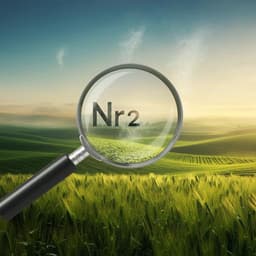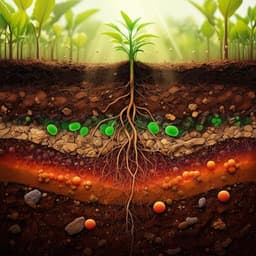Introduction
Human activities have significantly altered the global nitrogen cycle, primarily through increased nitrogen inputs from industrial sources and agriculture. Nitrification, the microbial oxidation of ammonia to nitrite and nitrate, is a crucial step in this cycle. However, high nitrification rates in agricultural systems often lead to nitrogen losses (leaching and eutrophication) and increased nitrous oxide (N₂O) emissions, reducing crop nitrogen use efficiency. Ammonia oxidation, the rate-limiting step of nitrification, is performed by AOA, AOB, and comammox bacteria. While AOA often dominate in pristine soils, AOB are typically considered the primary ammonia oxidizers in fertilized agricultural soils, largely responsible for N losses and N₂O emissions. The role of comammox bacteria in agricultural systems remains poorly understood. Previous studies using 1-octyne, a selective AOB inhibitor, suggested a prevalence of AOA activity at low ammonia inputs and lower N₂O yields from AOA compared to AOB. This study hypothesized that AOA activity linked to organic matter mineralization would be prominent in agricultural soils with high organic matter mineralization rates and high nitrogen fluxes. The researchers aimed to determine nitrification rates and N₂O yields without fertilizers or inhibitors in highly fertile agricultural soils in the Everglades Agricultural Area (EAA) of southern Florida, known for high organic matter content and carbon and nitrogen mineralization rates.
Literature Review
The existing literature highlights the significant impact of human activities on the global nitrogen cycle, particularly nitrification's role in nitrogen losses and N2O emissions from agricultural systems. The discovery of AOA and comammox bacteria significantly expanded our understanding of nitrifying microbial diversity. While studies using selective inhibitors like 1-octyne have shed light on the differential contributions of AOA and AOB to nitrification and N2O production, the precise roles of these groups in complex soil communities remain unclear. Previous research suggested that AOA might be more prevalent and efficient under low-ammonia conditions and exhibit lower N2O yields than AOB, emphasizing the need for further investigation in high-organic-matter agricultural soils.
Methodology
Soil samples were collected from five plots in the EAA: one unmanaged native plot and four agriculturally managed plots with varying cropping histories (sugarcane, spinach, sweet corn, rice). Net nitrification and N₂O production rates were determined in soil microcosms. Nitrification potentials were assessed using a modified method, substituting phosphate buffer with synthetic freshwater Crenarchaeota medium. Molecular analyses included clone library analysis of archaeal, bacterial, and comammox amoA genes, and 16S rRNA gene amplicon library preparation and sequencing. Quantitative PCR (qPCR) was used to quantify amoA gene abundance. Statistical analyses included Pearson correlations, ANOVA, and multivariate analyses (PCOA, CCA, dbRDA) to assess relationships between microbial community structure and environmental factors. The study used a combination of activity measurements, molecular techniques (qPCR and amplicon sequencing) and statistical analysis to understand nitrification rates and the relative contribution of ammonia-oxidizing groups in high-organic matter soils.
Key Findings
Net nitrification rates varied across plots but were not significantly different between plant-covered and fallow plots. N₂O production rates were low across all plots, and N₂O yields ranged from 0.18 to 0.41 ng N₂O-N per µg NOx-N, consistent with previous findings of low N₂O yields from AOA. qPCR revealed that archaeal amoA genes were significantly more abundant than bacterial and comammox amoA genes (27- to 120-fold for AOB and 65- to 430-fold for comammox), indicating AOA dominance. 16S rRNA gene amplicon sequencing confirmed this dominance, with Thaumarchaeota (primarily AOA) accounting for 2.42–6.37% of sequences, while AOB and comammox were much less frequent. Phylogenetic analysis revealed a diverse AOA community and low diversity AOB and comammox communities. Pearson correlations showed strong positive associations between DOC, C-mineralization, N₂O production, and net nitrification, indicating coupled C and N mineralization. dbRDA showed that soil pH and moisture content were the primary factors shaping both overall microbial and thaumarchaeal community structures. Low ammonium concentrations and high nitrate levels in fallow plots suggested that plants primarily utilized nitrate derived from AOA activity. Similar nitrification rates in plant-covered and fallow plots indicated that AOA may not be in direct competition with plants for reduced nitrogen. The low abundance of comammox suggests that they did not significantly contribute to the observed nitrification activity.
Discussion
The study's findings support the hypothesis that AOA dominate nitrification in highly fertile agricultural soils, even in the absence of selective inhibitors. The low N₂O yields observed further validate previous findings regarding AOA's lower N₂O production compared to AOB. The dominance of AOA in this system, despite high organic matter mineralization, challenges the prevalent assumption that AOB are the primary drivers of nitrification in agricultural soils. The study's results highlight the potential for manipulating agricultural practices to favor AOA activity and mitigate N₂O emissions. The lack of significant competition between AOA and plants for reduced nitrogen suggests a possible symbiotic relationship, where AOA provide a readily available nitrate source for plant uptake. The influence of pH and soil moisture on microbial community structure underscores the importance of considering environmental factors when predicting nitrification dynamics.
Conclusion
This study demonstrates the critical role of AOA in nitrogen cycling within a highly productive agricultural soil. The observed low N₂O yields from AOA-dominated nitrification confirm previous findings and indicate potential for N₂O emission reduction through targeted agricultural practices. The data suggest complex interactions between microbial nitrogen mineralization, AOA activity, and plant nitrogen uptake, warranting further investigation into plant-microbe interactions in this high-organic-matter soil system. Future research could explore the mechanisms of plant-microbe interactions, investigate the role of other nitrogen cycling processes, and assess the influence of seasonal variation on nitrification and microbial community dynamics.
Limitations
The study's focus on a single site limits the generalizability of the findings to other soil types and agricultural systems. The methods used did not fully distinguish between the activities of AOA and comammox bacteria. The microcosm experiments may not perfectly reflect in situ conditions, potentially influencing the accuracy of rate measurements. The statistical analysis had limited power to assess the influence of various environmental factors due to the relatively small number of plots analyzed.
Related Publications
Explore these studies to deepen your understanding of the subject.






